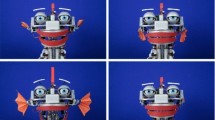Abstract
Affective robots and embodied conversational agents require convincing facial expressions to make them socially acceptable. To be able to virtually generate facial expressions, we need to investigate the relationship between technology and human perception of affective and social signals. Facial landmarks, the locations of the crucial parts of a face, are important for perception of the affective and social signals conveyed by facial expressions. Earlier research did not use that kind of technology, but rather used analogue technology to generate point-light faces. The goal of our study is to investigate whether digitally extracted facial landmarks contain sufficient information to enable the facial expressions to be recognized by humans. This study presented participants with facial expressions encoded in moving landmarks, while these facial landmarks correspond to the facial-landmark videos that were extracted by face analysis software from full-face videos of acted emotions. The facial-landmark videos were presented to 16 participants who were instructed to classify the sequences according to the emotion represented. Results revealed that for three out of five facial-landmark videos (happiness, sadness and anger), participants were able to recognize emotions accurately, but for the other two facial-landmark videos (fear and disgust), their recognition accuracy was below chance, suggesting that landmarks contain information about the expressed emotions. Results also show that emotions with high levels of arousal and valence are better recognized than those with low levels of arousal and valence. We argue that the question of whether these digitally extracted facial landmarks are a basis for representing facial expressions of emotions is crucial for the development of successful human-robot interaction in the future. We conclude by stating that landmarks provide a basis for the virtual generation of emotions in humanoid agents, and discuss how additional facial information might be included to provide a sufficient basis for faithful emotion identification.






Similar content being viewed by others
References
Vinciarelli A, Pantic M, Bourlard H (2009) Social signal processing: survey of an emerging domain. Image Vis Comput 27(12):1743–1759
Russell JA (1997) Reading emotions from and into faces: resurrecting a dimensional-contextual perspective. In: Russell JA, Fernandez-Dols JM (eds) The psychology of facial expressions. Cambridge University, New York, pp 295–320
Mondloch CJ (2012) Sad or fearful? The influence of body posture on adults and childrens perception of facial displays of emotion. J Exp Child Psychol 111:180–196
Aviezer H, Hassin R, Bentin S, Trope Y (2008) Putting facial expressions back in context. In: Ambady N, Skowronski JJ (eds) First impressions. Guilford, New York, pp 255–286
Breazeal CL Designing social robots. Personal Robots Group in MIT Media Lab, Cambridge
Breazeal CL (2000) Sociable machines: expressive social exchange between humans and robots. Diss Massachusetts Institute of Technology, pp 178–184
Breazeal CL (2003) Emotion and sociable humanoid robots. Int J Hum-Comput Stud 59(1):119–155
Saragih JM, Lucey S, Cohn JF, Court T (2011) Real-time avatar animation from a single image. In: Automatic face & gesture
Johansson G (1975) Visual motion perception. Sci Am 232:76–88
Bassili JN (1978) Facial motion in the perception of faces and of emotional expression. J Exp Psychol Hum Percept Perform 4:373–379
Tomlinson EK, Jones CA, Johnston RA, Meaden A, Wink B (2006) Facial emotion recognition from moving and static point-light images in schizophrenia. Schizophr Res 85(1–3):96–105
Saragih J, Lucey S, Cohn J (2011) Deformable model fitting by regularized landmark mean-shift. Int J Comput Vis 91:200–215
Lucey P, Lucey S, Cohn JF (2010) Registration invariant representations for expression detection. In: International conference on digital image computing: techniques and applications. I, pp 255–261
Alexander O, Rogers M, Lambeth W, Chiang M, Debevec P (2009) Creating a photoreal digital actor: the digital Emily project. In: Conference for visual media production, pp 176–187
Yang C, Chiang W (2007) An interactive facial expression generation system. Springer, Berlin
Bänziger T, Scherer KR (2010) Introducing the Geneva Multimodal Emotion Portrayal (GEMEP) corpus. In: Scherer KR, Bänziger T, Roesch EB (eds) Blueprint for affective computing: a sourcebook. Oxford University Press, Oxford, pp 271–294
Bänziger T, Mortillaro M, Scherer KR (2011) Introducing the Geneva multimodal expression corpus for experimental research on emotion perception. Emotion. doi:10.137/a0025827
Sinha P, Balas B, Ostrovsky Y, Russell R (2006) Face recognition by humans: nineteen results all computer vision researchers should know about. Proc IEEE 94(11):1948–1962
Cheng L, Lin C, Huang C (2012) Visualization of facial expression deformation applied to the mechanism improvement of face robot. Int J Soc Robot. doi:10.1007/s12369-012-0168-5
Kedzierski J, Muszynski R, Zoll C, Oleksy A, Frontkiewicz M (2013) EMYS—Emotive head of a social robot. Int J Soc Robot 5(2):237–249
Acknowledgements
The authors acknowledge anonymous reviewers for their constructive and detailed comments to an earlier version of this paper. We wish to express our gratitude to Ruud Mattheij, and Peter Ruijten, and the Persuasive Technology Lab Group at TU/e for the fruitful discussions about this work. The first author also appreciates the scholarship for her Ph.D. project from China Scholarship Council.
Author information
Authors and Affiliations
Corresponding author
Rights and permissions
About this article
Cite this article
Liu, C., Ham, J., Postma, E. et al. Representing Affective Facial Expressions for Robots and Embodied Conversational Agents by Facial Landmarks. Int J of Soc Robotics 5, 619–626 (2013). https://doi.org/10.1007/s12369-013-0208-9
Accepted:
Published:
Issue Date:
DOI: https://doi.org/10.1007/s12369-013-0208-9




